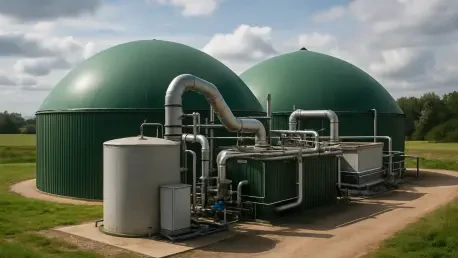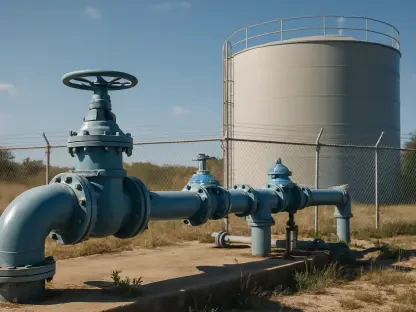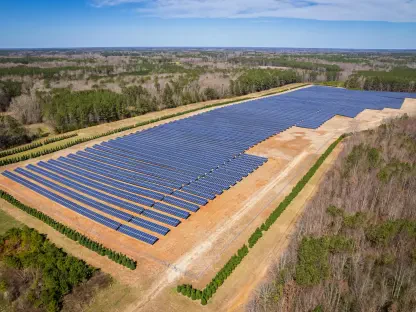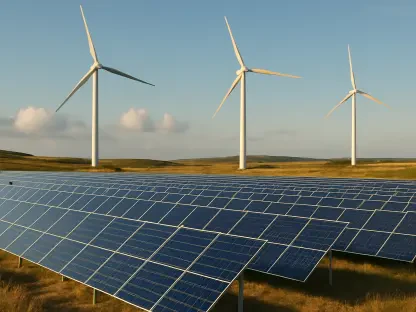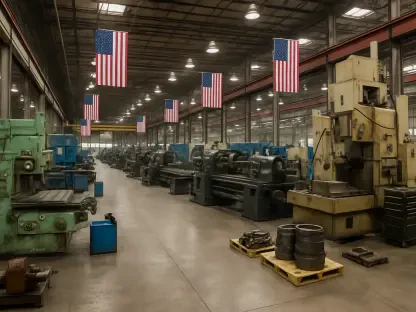In a world increasingly grappling with the dual challenges of energy security and environmental sustainability, the biogas market stands out as a promising solution that addresses both issues with remarkable efficiency. Derived from the anaerobic digestion of organic materials such as agricultural residues, municipal solid waste, and industrial by-products, biogas offers a renewable alternative to fossil fuels. Its versatility allows it to power electricity generation, fuel vehicles, provide heating, serve as cooking gas, and even be upgraded into biomethane for grid injection. As global awareness of climate change intensifies, this sector is gaining momentum, fueled by technological advancements and supportive policies. The market, valued at $133.61 billion in 2024, is on track to expand significantly over the coming years, reflecting a growing commitment to cleaner energy sources. This article explores the factors driving this growth, the role of innovation and government support, regional variations, and the competitive dynamics shaping the industry’s future.
Market Growth and Drivers
Key Growth Projections
The biogas market is poised for substantial expansion, with projections estimating its value to reach $222.4 billion by 2035, driven by a compound annual growth rate (CAGR) of 4.75% from the current year through the forecast period. This impressive trajectory is largely attributed to the escalating global demand for renewable energy sources as nations strive to mitigate the impacts of climate change. With fossil fuels contributing heavily to greenhouse gas emissions, biogas emerges as a viable low-carbon alternative that aligns with international sustainability goals. The urgency to transition away from traditional energy systems is evident in both developed and developing regions, where energy policies increasingly prioritize cleaner options. Additionally, the economic benefits of biogas, such as job creation in plant construction and operation, further bolster its appeal as an investment-worthy sector.
Beyond the environmental imperative, the growth of this market is also fueled by rising energy needs in urbanizing and industrializing regions. As populations grow and economies expand, the strain on conventional energy grids intensifies, creating a pressing need for decentralized and renewable solutions like biogas. This energy source not only reduces reliance on finite resources but also offers a stable supply through locally sourced organic materials. The financial outlook remains positive, with increasing investments from both public and private sectors signaling confidence in biogas as a cornerstone of future energy mixes. Such robust growth projections underscore the market’s potential to reshape how energy is produced and consumed globally.
Sustainable Waste Solutions
One of the most compelling advantages of biogas lies in its ability to address the mounting challenge of waste management, particularly in densely populated urban and industrial areas. As cities expand and industries scale up, the volume of organic waste generated—ranging from food scraps to wastewater sludge—poses significant environmental and logistical problems. Biogas technology transforms this waste into a valuable energy resource, reducing the burden on landfills and curbing methane emissions that would otherwise escape during decomposition. This dual benefit positions biogas as a critical tool in achieving sustainable urban development, especially in regions struggling with waste disposal infrastructure.
Furthermore, the integration of biogas production into waste management systems offers a practical pathway to a circular economy. By repurposing materials that would typically be discarded, municipalities and industries can generate electricity or heat while minimizing pollution. This approach is gaining traction in areas where landfill space is scarce and environmental regulations are tightening. The economic incentives are clear as well—turning waste into energy cuts disposal costs and creates revenue streams from power generation or fuel sales. As more stakeholders recognize these advantages, the adoption of biogas systems as a waste-to-energy solution is expected to accelerate, further driving market expansion.
Technological and Policy Support
Innovations in Production
Technological advancements are at the heart of the biogas market’s evolution, significantly enhancing the efficiency and applicability of this renewable energy source. Innovations in anaerobic digestion processes have improved the breakdown of organic materials, resulting in higher biogas yields and better gas quality. Upgrading techniques, which convert raw biogas into biomethane by removing impurities like carbon dioxide, are also advancing rapidly. This refined product can be injected into natural gas grids or used as a cleaner vehicle fuel, expanding the range of applications and making biogas a more competitive alternative to traditional energy sources. Such progress is pivotal in attracting investment and scaling up production capacity.
Equally important are the developments in modular and small-scale biogas systems, which cater to remote or rural areas where large infrastructure projects may not be feasible. These innovations lower the entry barriers for smaller enterprises or communities to adopt biogas technology, democratizing access to renewable energy. Enhanced monitoring and automation tools are also being integrated, ensuring consistent performance and reducing operational downtimes. As research continues to push the boundaries of what biogas systems can achieve, the market is likely to see even broader adoption across diverse sectors, from transportation to industrial heating, solidifying its role in the global energy transition.
Government Incentives
Government policies and incentives play an indispensable role in propelling the biogas market forward, acting as catalysts for widespread adoption across various regions. Many countries have implemented subsidies, tax breaks, and grants to offset the high initial costs of setting up biogas plants, making them more financially viable for investors and operators. Regulatory frameworks that mandate reductions in greenhouse gas emissions further encourage industries and municipalities to turn to biogas as a compliance strategy. These measures are particularly impactful in regions with ambitious renewable energy targets, where biogas is often positioned as a key component of national energy strategies.
In addition to financial support, governments are fostering market growth through legislative measures that promote waste-to-energy initiatives. Policies that prioritize the use of organic waste for energy production over landfill disposal are gaining prominence, aligning with broader environmental goals. International agreements on climate action also influence local policies, creating a ripple effect that boosts biogas projects worldwide. This supportive environment not only accelerates infrastructure development but also builds public and private sector confidence in biogas as a reliable and sustainable energy solution. As these policies evolve, they are expected to continue shaping the market’s upward trajectory.
Market Segmentation Insights
Feedstock Sources
The biogas market’s segmentation by feedstock sources—municipal, industrial, and agricultural—reveals the diverse foundations on which this industry operates. Municipal solid waste, particularly in urban settings, is a major contributor, as cities harness waste-to-energy technologies to manage household and commercial refuse. This segment is crucial in regions with high population densities, where waste accumulation is a persistent issue. By converting food scraps, yard waste, and other organic materials into biogas, municipalities can address sanitation challenges while generating renewable energy, creating a win-win scenario for urban planners and environmentalists alike.
Industrial feedstock, encompassing residues from food processing, breweries, and wastewater treatment, also plays a significant role in biogas production. This source supports energy generation within industrial facilities, often reducing operational costs and enhancing sustainability profiles for businesses. Meanwhile, agricultural residues and livestock manure dominate in rural areas, where farming communities leverage biogas systems to power operations and improve waste management practices. The diversity of these sources ensures a resilient supply chain, mitigating risks associated with dependency on a single type of feedstock. This variety strengthens the market’s adaptability to regional and seasonal variations in raw material availability.
Diverse Applications
Biogas demonstrates remarkable versatility through its wide array of applications, catering to an extensive range of energy needs across multiple sectors. Electricity generation remains a primary use, often facilitated by combined heat and power (CHP) systems that maximize energy output by capturing both electricity and thermal energy. This application is particularly valuable for grid-connected facilities and industrial operations seeking reliable renewable power. Additionally, biogas serves as a heating source for residential, commercial, and industrial settings, offering a sustainable alternative to conventional fuels in colder climates or energy-intensive processes.
Another growing application is the use of biogas as a vehicle fuel, typically in the form of compressed natural gas (CNG), which produces fewer emissions than gasoline or diesel. This trend is gaining momentum in public transportation and logistics sectors, where fleet operators aim to lower their carbon footprints. Upgraded biogas, or biomethane, further extends usability by enabling grid injection and broader fuel applications. In rural and off-grid areas, biogas as a cooking fuel provides a cleaner alternative to traditional biomass, reducing deforestation and indoor air pollution. These diverse uses highlight the adaptability of biogas, positioning it as a multifaceted solution to modern energy challenges.
Regional Market Dynamics
Leading and Emerging Regions
Regional variations significantly influence the biogas market, with Europe currently holding the largest share due to its advanced infrastructure and stringent environmental regulations. The European Union’s ambitious renewable energy targets have spurred countries like Germany, France, and Italy to invest heavily in large-scale biogas plants, focusing on waste-to-energy solutions and biofertilizer production. Integration with existing energy grids enhances the region’s leadership, making biogas a seamless part of the broader energy mix. This established framework serves as a model for other areas looking to scale up their renewable energy portfolios.
In contrast, North America represents a mature yet steadily growing market, with the United States and Canada leading the charge. Strong government incentives and a focus on anaerobic digestion in agriculture and municipal waste management drive expansion. Meanwhile, Asia-Pacific stands out as a region of rapid growth, fueled by industrialization, agricultural activities, and clean energy initiatives. Nations like China and India are scaling up biogas projects to tackle waste management challenges and bolster energy security. These regional disparities underscore the importance of tailored approaches to harness the full potential of biogas across different economic and policy landscapes.
Growth in Developing Areas
Emerging markets in Latin America, the Middle East, and Africa are beginning to tap into the potential of biogas, albeit at a more gradual pace compared to established regions. In Latin America, countries such as Brazil and Mexico are leveraging abundant agricultural waste to develop small- to medium-scale biogas projects. Government support and growing awareness of sustainability are key factors driving interest, even as challenges like funding and technical expertise persist. These initiatives often focus on rural electrification and energy diversification, addressing local needs with context-specific solutions.
The Middle East and Africa present unique opportunities as well, with the Gulf Cooperation Council (GCC) countries investing in renewable energy infrastructure to complement their oil-based economies. In African nations, decentralized biogas systems are gaining traction as a means to improve energy access, particularly in remote areas. These projects often target organic waste management and sustainable development goals, aligning with broader efforts to combat energy poverty. While still in early stages, the increasing focus on renewable solutions in these regions signals a promising future for biogas adoption, provided barriers like financial constraints and logistical hurdles are addressed.
Competitive and Strategic Developments
Industry Players and Innovation
The biogas market features a dynamic competitive landscape, characterized by a mix of multinational energy companies, technology providers, and regional players. Leading firms are heavily investing in research and development to enhance biogas yields and improve purification technologies, ensuring higher efficiency and broader applicability. Innovation remains a cornerstone of competition, with companies exploring advanced anaerobic digestion methods and biogas upgrading solutions to meet stringent quality standards. These efforts are critical in positioning biogas as a credible alternative to conventional energy sources in both developed and emerging markets.
Strategic partnerships and collaborations also define the industry’s direction, as companies seek to combine expertise and resources for greater impact. Joint ventures often focus on scaling up production capacity or entering new geographic markets with tailored solutions. The emphasis on sustainability drives many of these initiatives, with firms developing integrated systems for organic waste management and renewable electricity generation. This focus aligns with global climate goals, enhancing the market’s appeal to environmentally conscious investors and policymakers. As competition intensifies, innovation will continue to shape the strategies of key players striving for market leadership.
Recent Market Moves
Recent developments within the biogas sector highlight its dynamic and rapidly evolving nature, with significant investments signaling strong growth potential. For instance, substantial funding has been directed toward expanding biogas facilities in regions like India, where localized projects aim to address both energy and waste management needs. Such financial commitments reflect a growing recognition of biogas as a scalable solution that can be adapted to diverse regional contexts. These initiatives often prioritize community-level impact, ensuring that benefits like job creation and energy access are realized alongside environmental gains.
Moreover, global efforts to deploy agricultural biogas systems are gaining momentum, with funding rounds supporting the rollout of technologies designed for rural settings. These moves underscore an industry-wide shift toward solutions that are not only sustainable but also accessible to underserved populations. The focus on localized and modular systems demonstrates a strategic response to the unique challenges faced by different markets, from feedstock availability to infrastructure limitations. As more players enter the space with innovative approaches, the biogas market is likely to see accelerated growth, further cementing its role in the global transition to renewable energy.
